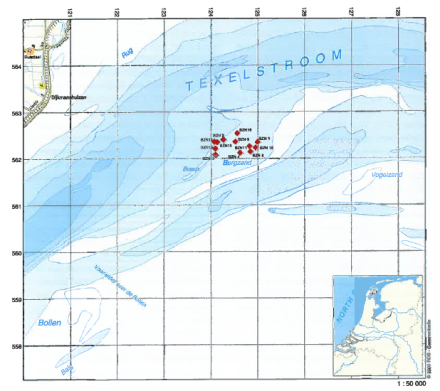History
In July 1985, a Wadden Sea fisherman's net got caught on the seafloor. Suspecting the cause of the problem, he informed a local dive team, led by Hans Eelman. Their investigation of the site led to the discovery of a well-preserved wooden shipwreck, lying at a depth of around 6 m. The wreck was determined to measure around 40 m in length, with a width of ca. 15 m. Among several items that were lifted was a bronze Admiralty cannon dated 1638, which would prove to be crucial in the identification of the vessel.
Archaeological investigations
Further dives on the site by the underwater archaeology department of the Dutch government offered many new insights into the wreck. Large parts of the wooden ship construction, such as the bow, were found to be completely intact, and hinted at an extra deck in the cargo hold – historically known as a typical feature of Dutch East Indiamen. The find of several more cannons at the site, suggested that the vessel was well armed.
Dendrochronological analysis of wood samples taken from the bow of the ship produced a felling date of 1640 (± 5) AD, thus providing an estimated building date of the vessel. The demise of the ship was placed around 1640, as suggested by the many dated golden and silver coins collected at the site. Most of these were Dutch in origin, although several rolls of foreign coins were also found. These may have been intended for use in foreign trade.

Identification
Burgzand Noord 3 (BZN 3) is cautiously identified as the Rob, a Dutch East India Company (VOC) merchantman that was prepared for a voyage to the East Indies in 1639. Before it was ready to set sail, the States General requested that the ship be loaded with cannons and other military equipment, and the Rob was lent to the Admiralty.
That year in October the ship participated in the famous Battle of the Downs, under command of Cornelis Cornelisz. Jol, nicknamed 'Houtebeen' (pegleg). In January of the following year, a historic storm hit Texel, sinking many ships at anchor in its path, among which the Rob.
The identification of BZN 3 as the Rob is based on its dating, its location and some constructional features which roughly point to a VOC design. As no VOC-marked items have been found at the site, this identification is deemed likely, but far from certain.
Description
Burgzand Noord 3 is a 17th-century wooden shipwreck, named after the Wadden Sea area near the Dutch island of Texel where it was discovered in 1985. The wreck may possibly be that of the Dutch East Indiaman the Rob, which sank in the Texel roadstead on January 5, 1640.
- Length: 40-45 m
- Beam: ca. 15 m

Status
Given its archaeological and historic significance and excellent physical condition, Burgzand Noord 3 was declared a historical monument by the Dutch government in 1988. Shortly afterwards, the site also received physical protection. The site was largely covered in scaffolding sheet in order to catch sand particles, and the relief of the seabed was softened with 5000 sandbags. This resulted in a natural mound on the seafloor, preventing looting, erosion of the site and damage by shipworms. Although this method has proven largely successful, the dynamic conditions at the site call for frequent monitoring and further physical protection. Many inspections have since been carried out of Burgzand Noord 3.





References
- Brenk, S. van den & M.R. Manders, 2014: Monitoring Scheepswrakken Burgzand Noord Periode 1998-2013, Periplus Archaeomore/RCE Rapport 13-A031, Amsterdam.
- Preserving a layered history of the western Wadden Sea: managing an underwater cultural heritage.
- Onderwaterarcheologie op de rede van Texel (NAR 41).